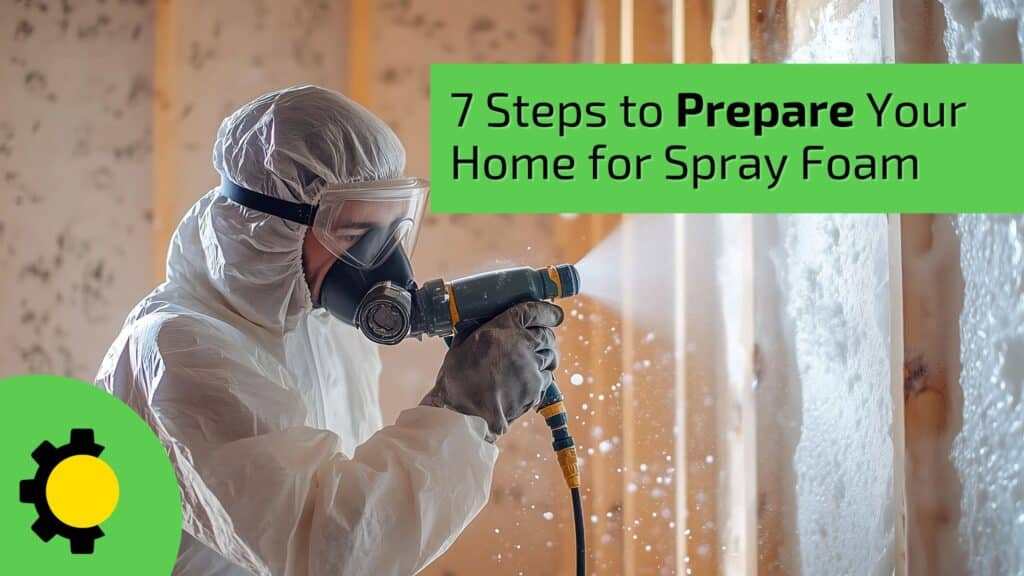Spray foam insulation is one of the most effective ways to improve your home’s energy efficiency, indoor comfort, and long-term durability. Whether you’re sealing an attic, crawl space, or entire home, spray foam creates an airtight barrier that helps regulate temperature and control moisture. But before the installation can begin, it’s important to properly prepare your home to ensure the best results.
At Sunlight Contractors, we’ve completed thousands of spray foam projects across Louisiana, and we know firsthand how critical the preparation phase is. Taking a few simple steps ahead of time can streamline the installation, protect your belongings, and ensure your new insulation performs at its best. Here’s what homeowners need to know before installation day.
Why Preparation Matters
While spray foam insulation offers excellent long-term benefits, it requires a careful and controlled installation process. Preparation is key for several reasons:
- Efficiency: A clean, accessible work area allows installers to work more quickly and effectively.
- Safety: Proper preparation helps prevent accidental damage to your belongings and limits your exposure to fumes during application.
- Performance: Spray foam adheres best to clean, dry surfaces. Addressing moisture, mold, or debris beforehand ensures a strong, lasting seal.
Skipping these steps could lead to delays, increased costs, or compromised results. With a little planning, you can help your insulation investment pay off for years to come.
7 Steps for Preparing a Home for Spray Foam Insulation
Clear the Work Area
Before your insulation team arrives, it’s important to remove anything that could get in the way. This includes:
- Furniture and storage items in the area being insulated — such as boxes in the attic or shelving in the garage.
- Floor coverings or rugs that could be damaged by foot traffic or overspray.
- Personal belongings that might be exposed to dust or debris during the process.
If removal isn’t possible, cover remaining items with plastic sheeting or drop cloths. Installers will also need room to bring in equipment, so clear a path through hallways, stairwells, and entryways. A little effort now can make installation day go much more smoothly.

Protect Your Belongings
Even with careful application, spray foam insulation can release particles and fumes during the installation process. To safeguard your home and possessions:
- Cover surfaces and furniture near the work zone with plastic tarps or drop cloths.
- Remove electronics, artwork, or delicate materials that could be damaged by dust or temperature changes.
- Seal vents and HVAC registers in the area being insulated to prevent particles from circulating throughout your home.
Taking these precautions not only protects your property but also makes post-installation cleanup easier.
Plan for Ventilation and Temporary Relocation
During installation, spray foam gives off fumes that may be irritating or harmful if inhaled in large quantities. As a safety precaution:
- Vacate your home for at least 24 hours after installation, or as recommended by your contractor.
- Make arrangements for children, pets, and individuals with respiratory issues to stay elsewhere during this time.
- Ensure good ventilation in the work area if it’s safe to do so before the team arrives.
Your Sunlight Contractors team will inform you when it’s safe to re-enter your home, and they’ll take every precaution to minimize exposure during and after installation.
Seal Off Adjacent Spaces
To keep the spray foam application as contained and clean as possible, you’ll want to isolate the insulation zone from the rest of your home:
- Use plastic sheeting or zip walls to separate rooms, hallways, or open doorways.
- Close off air vents or ductwork connected to the work area to prevent cross-contamination.
- Block off any nearby electronics or sensitive equipment that may be exposed to overspray.
By sealing off nearby spaces, you help create a safer, more controlled environment for both your home and the insulation crew.
Address Any Pre-Installation Repairs
For spray foam to adhere properly and perform effectively, the surfaces being treated must be in good condition. Before installation:
- Inspect for moisture issues, such as leaks or dampness in attics, crawl spaces, or basements.
- Check for signs of mold, mildew, or pests, and treat these issues before insulation begins.
- Complete any necessary electrical or structural repairs that could affect access or safety during the project.
Spray foam acts as a powerful sealant, so it’s crucial that all underlying issues are resolved ahead of time — once applied, the foam will make access to these areas much more difficult.

Talk to Your Contractor
Every home is different, and your insulation project may have unique needs. You can ask any spray foam question to your contractor before installation. Before installation day:
- Schedule a walkthrough with your spray foam contractor to discuss any concerns or questions.
- Ask about site-specific recommendations, especially for older homes or complex structures.
- Review timelines and safety protocols so you know exactly what to expect before, during, and after installation.
At Sunlight Contractors, we take the time to communicate clearly with every homeowner to ensure the process is smooth from start to finish. Your comfort, safety, and satisfaction are our top priorities.
Final Thoughts
Spray foam insulation is one of the smartest upgrades you can make to your home — but proper preparation is key to getting the most out of your investment. By clearing the workspace, protecting your belongings, and working closely with your contractor, you’ll help ensure a safe, efficient, and long-lasting installation.
Ready to insulate your home with the experts? Contact Sunlight Contractors today for a free consultation and discover why homeowners across Louisiana trust us for high-quality spray foam insulation.

